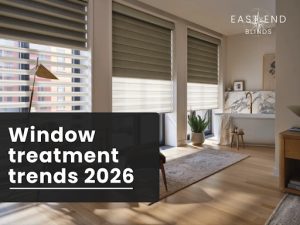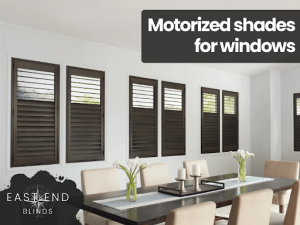
Choosing the right window shades for your dining area can transform the space, creating the perfect ambiance for meals and gatherings. Whether you’re looking for privacy, light control, or an aesthetic upgrade, selecting the ideal shades can significantly enhance your dining experience. With so many options available, from sleek roller shades to elegant Roman styles, making a choice can be daunting.
Table of Contents
Key Takeaways |
✔ Select shades based on the amount of light you want to filter or block, with options ranging from sheer to blackout.
✔ For privacy, choose shades that offer the right level of coverage, such as dual shades or blackout options for full privacy.
✔ Match your window shades with your dining room’s style, whether it’s traditional, modern, rustic, or eclectic, to ensure a cohesive look.
✔ Consider customization options like motorization for convenience or custom-made shades for a perfect fit and personalized design.
✔ Familiarize yourself with different types of shades, like roller, Roman, cellular, pleated, sheer, blackout, and woven wood, as each offers unique benefits.

How to Choose the Right Residential Window Shades for Your Dining Area
Assess Your Dining Area’s Needs
The first step in choosing the right residential window shades is understanding your dining area. Evaluate the room’s size, layout, and the amount of natural light it receives. A small, cozy dining nook may benefit from shades that maximize light to create an open feel, while a larger, sun-drenched room might require shades that provide more light control to avoid glare during meals. The orientation of the windows also plays a role; for instance, south-facing windows might need shades that can handle intense sunlight, whereas north-facing windows might prioritize light enhancement.
Consider Lighting Preferences
Considering natural lighting when choosing the right window shades is essential since it can positively impact residents’ mood and cognitive function. Residential window shades come in various opacity levels, from sheer to blackout, allowing you to tailor the light entering the space. If the dining area is primarily used during the day, shades that allow ample natural light while reducing glare can create a bright, welcoming environment. For evening meals, you might prefer shades that offer a warm, inviting atmosphere by diffusing the light softly or even blocking out excess light for a cozy setting.
Identify Privacy Concerns
Privacy is another crucial factor when choosing residential window shades. If your dining area faces a busy street or has neighbors in close proximity, shades that offer varying levels of opacity are essential. Options like sheer shades provide minimal privacy, suitable for secluded areas, while dual shades or blackout shades can offer complete privacy, ensuring you can enjoy your meals without concerns about prying eyes. It’s also worth considering top-down, bottom-up shades that provide flexibility by allowing light in while maintaining privacy at eye level.
Complement Your Shades with Existing Decor
Whether your style is modern, traditional, or eclectic, there’s a shade style that can enhance your interior design. Consider colors, patterns, and materials that will harmonize with your furniture and overall theme. For instance, Roman shades with rich fabrics can add elegance to a classic dining room, while sleek roller shades might suit a minimalist or contemporary setting. Additionally, consider how the texture and color of the shades will interact with the room’s natural and artificial lighting.
Consider Your Budget
Setting a budget is essential before diving into the myriad of options available for residential window shades. Prices can vary significantly based on the material, brand, and customization options. Knowing your budget will help narrow down choices and prevent overspending. It’s important to balance quality with cost, ensuring that the shades you choose are durable and meet your functional and aesthetic needs. Remember to factor in additional costs such as installation, especially if you opt for motorized or custom shades, which might require professional assistance.
Consider Customization and Features
When choosing residential window shades, consider the various customization options and features that can enhance both functionality and aesthetics:
Motorization
Motorized shades offer the ultimate convenience, especially for hard-to-reach windows. They can be operated via remote control, smartphone app, or integrated into smart home systems like Alexa, Google Home, or Apple HomeKit. This feature is particularly beneficial for large dining rooms or homes with high windows, allowing for effortless adjustments of your residential window shades to control light and privacy throughout the day.
Additionally, motorization allows for cordless window shades, which significantly reduces window cord entanglement injuries accounting for 11.9% of cases among American children under 6 years old.
Custom vs. Ready-Made
Decide whether to opt for custom-made shades, which provide a perfect fit and allow for a personalized touch in terms of fabric, color, and design. Custom shades are ideal if you have specific aesthetic requirements or non-standard window sizes. On the other hand, ready-made residential window shades are more budget-friendly and available for immediate installation. They come in standard sizes and styles, offering a quicker and more cost-effective solution while still providing a range of aesthetic choices.
Accessories
Enhance your residential window shades with decorative accessories like valances, cornices, and trims. Valances are soft fabric treatments that conceal the top of the shades, adding a polished look to your windows. Cornices are box-like structures that sit above the shades, providing a more structured and formal appearance. Decorative trims can add a splash of color or texture, complementing your dining room decor and tying the look together.
Measure and Plan for Installation
Accurate measurements are crucial to ensure your residential window shades fit perfectly and function as intended. First, decide between an inside mount, which fits the shades within the window frame for a clean, unobtrusive look, or an outside mount, which covers a larger area and can make windows appear bigger while blocking more light. For an inside mount, measure the width and height inside the frame at multiple points and use the smallest measurements; for an outside mount, measure the desired coverage area, accounting for additional overlap to minimize light gaps.
Consider whether to install the shades yourself or hire a professional; while DIY installation can save costs, professional installers ensure a precise fit and can manage complexities like motorization or challenging window placements, making it a worthwhile investment for more complicated installations.
Test Samples and Make a Final Decision
Testing samples and swatches is a critical step in selecting the right residential window shades. Request fabric samples from your chosen supplier to evaluate how the material looks and feels in your dining area under different lighting conditions. This helps you understand the impact of both natural and artificial light on the shades’ appearance, ensuring they align with your design vision.
Focus on the color, texture, and opacity of the samples to ensure they complement your dining room’s color scheme, furniture, and overall decor, and provide the desired level of light control and privacy. After thoroughly evaluating the samples, make your final decision based on practical needs and aesthetic preferences, ensuring the chosen shades blend seamlessly into your dining area. If uncertain, consulting with a design professional can provide valuable insights and help refine your choice, ensuring satisfaction with the final selection.
7 Types of Residential Window Shades Best for Dining Areas
1. Roller Shades
Roller shades are user-friendly and low-maintenance, offering excellent light control and privacy options. Available in a wide range of materials, from sheer to blackout, they can be tailored to suit various lighting and privacy needs. However, they offer limited insulation compared to other types of residential window shades, which may not make them the best choice for energy efficiency.
2. Roman Shades
Roman residential window shades are known for their soft fabric folds, adding an elegant, sophisticated look to any dining area. They create a series of horizontal pleats when raised, which stack neatly and provide a tailored appearance. They provide effective light control and can be lined for added privacy or complete blackout. The downside is that they can be harder to clean due to the folds, where dust and dirt can accumulate, and they may not fit well with highly modern or minimalist decor.
3. Cellular Shades (Honeycomb)
Cellular residential window shades, or honeycomb shades, feature a unique honeycomb structure that traps air, offering superior insulation. This design helps regulate indoor temperatures and enhance energy efficiency. Cellular shades are also excellent for energy savings, helping to keep the dining area warm in the winter and cool in the summer.
They are available in different opacity levels, from sheer to blackout, allowing precise light control. However, their modern look may not appeal to everyone, particularly in more traditional settings, and the delicate fabric requires careful handling to avoid damage.
4. Pleated Shades
Pleated shades are made from a single layer of fabric folded into crisp pleats, similar in appearance to cellular shades but without the air-trapping cells. Pleated shades are versatile, offering good light control and available in a wide range of colors and patterns. They are a cost-effective option for those seeking a stylish look without the extra insulation properties of cellular shades. However, the pleats can lose their sharpness over time, particularly in humid environments, and they offer less insulation compared to other shade types.
5. Sheer Shades
Sheer residential window shades combine a sheer fabric with adjustable horizontal vanes, allowing soft light to diffuse into the room while offering privacy control. Sheer shades provide a gentle, diffused light, perfect for creating a soft ambiance in dining areas. They are ideal for spaces that benefit from natural light but still require some level of privacy. However, they may not offer complete privacy at night when lights are on inside, and they are generally more delicate than other residential window shades, making them less durable in high-traffic areas.
6. Blackout Shades
Blackout shades are crafted from opaque materials designed to block out all external light, making them ideal for complete darkness. Blackout shades are excellent for those who need maximum privacy and light control, such as in dining rooms used for evening entertaining or home theaters. They help create a cozy, dark environment, but can make a room feel too dark if not balanced with lighter decor elements. Additionally, their primary focus on blocking light may not appeal to those who prefer a more naturally lit space.
7. Woven Wood Shades
Woven wood shades are made from natural materials like bamboo, grasses, and reeds, bringing texture and warmth to a room. These shades add a natural, earthy touch to any decor. They can be lined for additional privacy or light control. However, on their own, they may not provide complete privacy or light control, and the natural fibers can be susceptible to warping in high-humidity environments.
How to Match Residential Window Shades to Your Dining Area’s Style
Choosing the right residential window shades involves more than just picking a style; it’s about enhancing the overall aesthetic of your dining area. Whether your decor leans toward traditional elegance, modern minimalism, rustic charm, or eclectic creativity, there’s a perfect window shade option to complement and elevate your space.
Traditional Dining Rooms
Recommended Shades: Roman shades, pleated shades
Traditional dining rooms often feature rich, timeless elements such as dark wood furniture and classic decor. To match this aesthetic, choose residential window shades that exude sophistication and elegance.
Roman shades, with their soft, cascading folds, offer a luxurious appearance that complements traditional settings. Opt for rich fabrics like damask, silk, or heavy cotton in warm, neutral tones such as beige, cream, or taupe.
Pleated shades are another excellent choice, providing a structured yet soft look that harmonizes with classic decor. Adding decorative trims, tassels, or valances can further enhance the elegance of these shades, making them a focal point in the room.
Modern and Minimalist Dining Rooms
Recommended Shades: Roller shades, cellular shades
Modern and minimalist dining rooms are characterized by clean lines, simplicity, and a focus on function. For these spaces, choose residential window shades that reflect these principles.
Roller shades are ideal due to their sleek and unobtrusive design, which aligns with the minimalist ethos. Select shades in neutral colors such as white, gray, or black to maintain the room’s understated palette. Materials like smooth fabrics or metallic finishes can add a subtle contemporary edge without overwhelming the minimalist aesthetic.
Cellular shades are another excellent option, offering a modern look along with practical benefits like energy efficiency. Their honeycomb structure not only provides insulation but also contributes to the sleek appearance desired in modern interiors.
Rustic and Farmhouse Dining Rooms
Recommended Shades: Woven wood shades, Roman shades
Rustic and farmhouse dining rooms celebrate natural materials and earthy tones, creating a warm and inviting atmosphere.
Woven wood shades, made from bamboo, grasses, or reeds, are perfect for these spaces as they bring in natural textures and complement elements like exposed beams and stone accents. These shades add a rustic feel and can be lined to adjust for privacy and light control, making them versatile for different lighting needs.
Roman shades in soft, natural fabrics such as linen or burlap can add a cozy, homey vibe, blending seamlessly with the rustic decor. For color choices, consider shades that echo the natural palette of the room—think earthy browns, soft greens, or muted grays. These tones enhance the connection to nature and reinforce the room’s organic feel.
Accessories like simple wooden curtain rods or leather tiebacks can further enhance the rustic charm, adding a finishing touch that ties the entire look together.
Eclectic and Bohemian Dining Rooms
Recommended Shades: Sheer shades, Roman shades
Eclectic and bohemian dining rooms are all about creativity, vibrant colors, and a mix of patterns and textures. This style allows for a lot of personal expression, making it perfect for those who love to mix and match.
Sheer shades are a fantastic choice for these spaces as they provide soft, diffused light that enhances the room’s relaxed and laid-back vibe. These shades can be layered with curtains in bold prints or vibrant colors to add depth and interest.
Roman shades also work well, especially in fabrics with unique patterns or rich textures. Don’t shy away from experimenting with bright hues or unconventional designs; the goal is to create a dynamic and personalized space.

Frequently Asked Questions
Can window shades help improve the acoustics in my dining room?
Yes, certain types of window shades, like heavier Roman shades or drapes, can help improve acoustics by absorbing sound. This is particularly beneficial in dining areas with hard surfaces, which can create echoes. Adding these shades can create a more intimate and comfortable dining experience by reducing noise levels.
Are there eco-friendly options for residential window shades?
Yes, there are several eco-friendly options available. Shades made from natural materials like bamboo, reeds, and organic cotton are sustainable and environmentally friendly. These materials not only reduce the ecological footprint but also add a natural, earthy vibe to the dining room. Additionally, cellular shades are energy-efficient, helping to maintain indoor temperatures and reduce utility bills.
How do I choose window shades that complement an open floor plan?
In open floor plans, it’s essential to maintain a consistent aesthetic. Choosing shades in neutral colors that blend with the overall decor of adjacent spaces helps achieve this. Additionally, using the same style or coordinating fabric across different areas can create a seamless flow. For example, if the dining area flows into a living room, using matching or complementary shades can unify the spaces.
Transform Your Dining Area — Shop at East End Blinds in East Hampton, NY!
East End Blinds is your premier destination for high-quality residential window shades that blend style with functionality in East Hampton, NY. With a stunning array of options, from sleek roller shades to elegant Roman designs, East End Blinds offers custom solutions tailored to your specific needs. Whether you’re aiming to enhance privacy, control natural light, or simply add a touch of sophistication to your living space in East Hampton, NY, our company provides expert consultation and installation services. We that every detail, from fabric selection to fitting, is handled with precision, making it the ultimate choice for homeowners seeking to beautify their interiors.
Trust East End Blinds to transform your windows into stylish, functional focal points that reflect the charm and elegance of East Hampton, NY.





